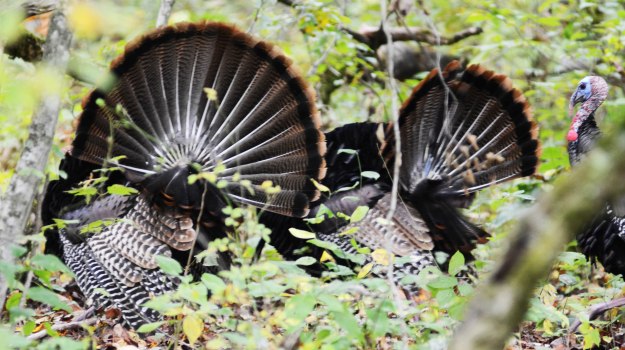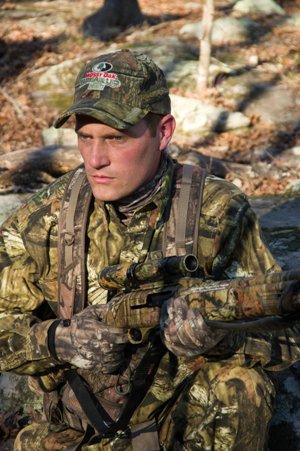
Editor’s Note: Bob Walker of Livingston, Alabama, a Mossy Oak turkey pro, also is one of the hosts on the Mossy Oak “Turkey THUGS” TV show. Walker has been a turkey hunting guide at Bent Creek Lodge in Jachin, Ala., for more than 30 years and has hunted turkeys his entire life. Walker believes if you know what the turkey knows, then you can take more toms.
When my turkey hunter and I arrive in the woods where we’re going to hunt, I try to make sure that my hunter has his gun and shells for his gun. Also, when he steps out of the truck, I’ll have him load his gun as quietly as possible and be sure not to let the receiver slam against the action. I want to be certain he has his gun on safety and his mask around his neck and knows where both of his gloves are. Then we’ll start moving as quietly as possible to go to the place where we hear a turkey gobbling. I'm never in a big hurry to reach a gobbler that’s gobbling from a limb. I slow walk because when the turkey is on the limb, as soon as he finishes his gobbling, he’s listening much more attentively than he will at any other time of the day. The gobbler knows that as long as he's in that tree gobbling, he's safe. He understands that predators, turkey hunters and hens can hear him gobbling. He's listening for his hens to answer him and for predators walking and trying to hear any sound that he can identify as a hunter. So, I don’t want me and my hunter to be close enough for the turkey to hear us from the roost. I'm basically trying to kill time until I hear the turkey fly off the roost or hear him gobble from the ground.
If our area has had a heavy dew or rain at night, if we’re walking along the edge of a sandy creek, or if I'm hunting with another hunter who knows how to walk in turkey woods, I’ll try to get closer. Also, if the day is a little windy and hides the sound of our movements, I’ll move in closer. When we start to the place where we’ll set-up to call the turkey, I like for my hunter to be about 10 yards behind me, so I can set the pace. Also, I know the hunter will have plenty of time to see where he needs to put his foot next. If I stop, I want the hunter to stop, which enables us to still hear a turkey gobble or hens call. But if you have your hunter right beside you or right behind you, more than likely, neither one of you will be able to hear a turkey gobble or a hen yelp.
On the way to the hunt that morning, I instructed my hunter not to drop his turkey cushion on the ground when we got ready to sit down. I explained that a turkey could hear from a long way off. I showed him how to sit down quietly. Then, once my hunter was sitting down, I took my pruning shears and tried to cut down any obstruction that may prevent him from seeing the turkey or making a clean shot on the turkey. I'm also conscious of any kind of little twigs that might interfere with the movements of my hunter’s shotgun barrel, if he has to turn to make the shot. At the same time, I'm clearing the area in front of my hunter, I whisper, “Don’t make a sound. Don’t make a sound.” Next, I make sure my hunter pulls up his mask, has his gloves on, and has none of his clothing or his watch showing, outside of his Mossy Oak camo pants and shirt.
When I finally sit down, especially with a new hunter, if he's a right-handed shooter, I sit right behind his right shoulder. Most of the time, I’ll sit primarily on the left cheek of my butt, leaning in to the tree to allow me to look right down the barrel of my hunter’s shotgun. When he brings his gun to his shoulder, I want to have the same field of view that my hunter has. I want to be able to see what the hunter sees at the same time the hunter sees it. Then I can see when the hunter has a clean shot on the turkey. For instance, I can tell him, “I'm going to yelp to the turkey. When he sticks his head up, aim for the wattles, and take him.” By sitting that close to my hunter and seeing what he sees, I can whisper instructions to my hunter, even if the turkey is within 20 yards.
Once we think the turkey is coming our way, I want my hunter to get his knee up and rest his shotgun on his knee. He still can relax. But when I see the turkey, I’ll say, “Okay, here he comes. Put your gun on your shoulder; use two fingers to get your safety off, so it doesn’t make any noise; follow the turkey with your gun barrel; and make sure your cheek is against the stock. When you’ve got the shot, aim for the wattles.” When the hunter shoots, and I see the turkey flopping, I jump up. I’ll grab the hunter’s gun because I really don’t feel comfortable with my hunter having his loaded gun at the ready, his safety off, and me between him and the turkey and start running to the turkey. I've often seen turkeys flop, jump up and take off. I'm sitting on my knees behind the hunter, so I can get up faster than he can, since he’s sitting on his butt. Everyone I hunt with tries hard to be safe.
 But when that adrenaline hits a hunter after he's taken a turkey, you never know what will happen. When most hunters shoot gobblers and see they’re down, they don’t put their guns back on safety, which means a hunter is wallowing around on the ground, trying to stand up with a loaded shotgun that’s not on safety. That’s why after the shot, I much prefer to be the one responsible for the gun. Occasionally but not very often, I’ll forget to tell my hunter, “After you shoot the turkey, I'll take your gun with me to retrieve the turkey.” I have had some inexperienced hunters say later, “Man, I didn’t know what was going to happen after you took my gun. I thought maybe I had missed.” Taking the hunter’s gun is a safety procedure that I've always been taught to use. I know I can get to a downed gobbler faster than any hunter I hunt with, because I’m expecting to have to jump up and run. As soon as I take the hunter’s gun, in the same motion, I’ll put the gun on safety.
But when that adrenaline hits a hunter after he's taken a turkey, you never know what will happen. When most hunters shoot gobblers and see they’re down, they don’t put their guns back on safety, which means a hunter is wallowing around on the ground, trying to stand up with a loaded shotgun that’s not on safety. That’s why after the shot, I much prefer to be the one responsible for the gun. Occasionally but not very often, I’ll forget to tell my hunter, “After you shoot the turkey, I'll take your gun with me to retrieve the turkey.” I have had some inexperienced hunters say later, “Man, I didn’t know what was going to happen after you took my gun. I thought maybe I had missed.” Taking the hunter’s gun is a safety procedure that I've always been taught to use. I know I can get to a downed gobbler faster than any hunter I hunt with, because I’m expecting to have to jump up and run. As soon as I take the hunter’s gun, in the same motion, I’ll put the gun on safety.
I had a hunter once from South Carolina. We got this turkey so close to us that we could hear him drumming, but we couldn’t tell exactly where the bird was located. Finally, the turkey came out from behind us, and my hunter got the shot. When my hunter shot the turkey, I jumped up, but I didn’t grab my hunter’s gun, because I thought the turkey was stone, cold dead. I had hunted with this hunter for several years, and I knew he was an extremely-safe hunter. He was a large fellow who required a little time to get up. As I closed the distance on the turkey, I could see that he was flopping and dragging his wings. Finally, the turkey started running. Two big pine trees were out in front of the turkey. The pine trees had one strand of shin-high barbed wire between them that had been there for a long time. I was running as hard as I could run. But when I hit that one strand of barbed wire - the barbed wire didn’t break. I did a complete flip in the air and landed on my face. The next thing I remember was hearing my hunter say, “See if you can get up. I'm sure you’ve broken something. I've got to get you to the hospital.” On this hunt, I had more blood on me than the turkey had on him. That turkey survived to be hunted another time, but I wasn’t too quick to heal.
So the moral of the story is: when you go turkey hunting, you never know what the turkey will do, even though you think you do. You never know what your turkey hunting partner will do, although you think you do. Also, you never really know what you’ll do, even though you think you do.
To get a free turkey eBook, “The Turkey Gobbler Getter Manual,” go to http://johninthewild.com/free-books.




























